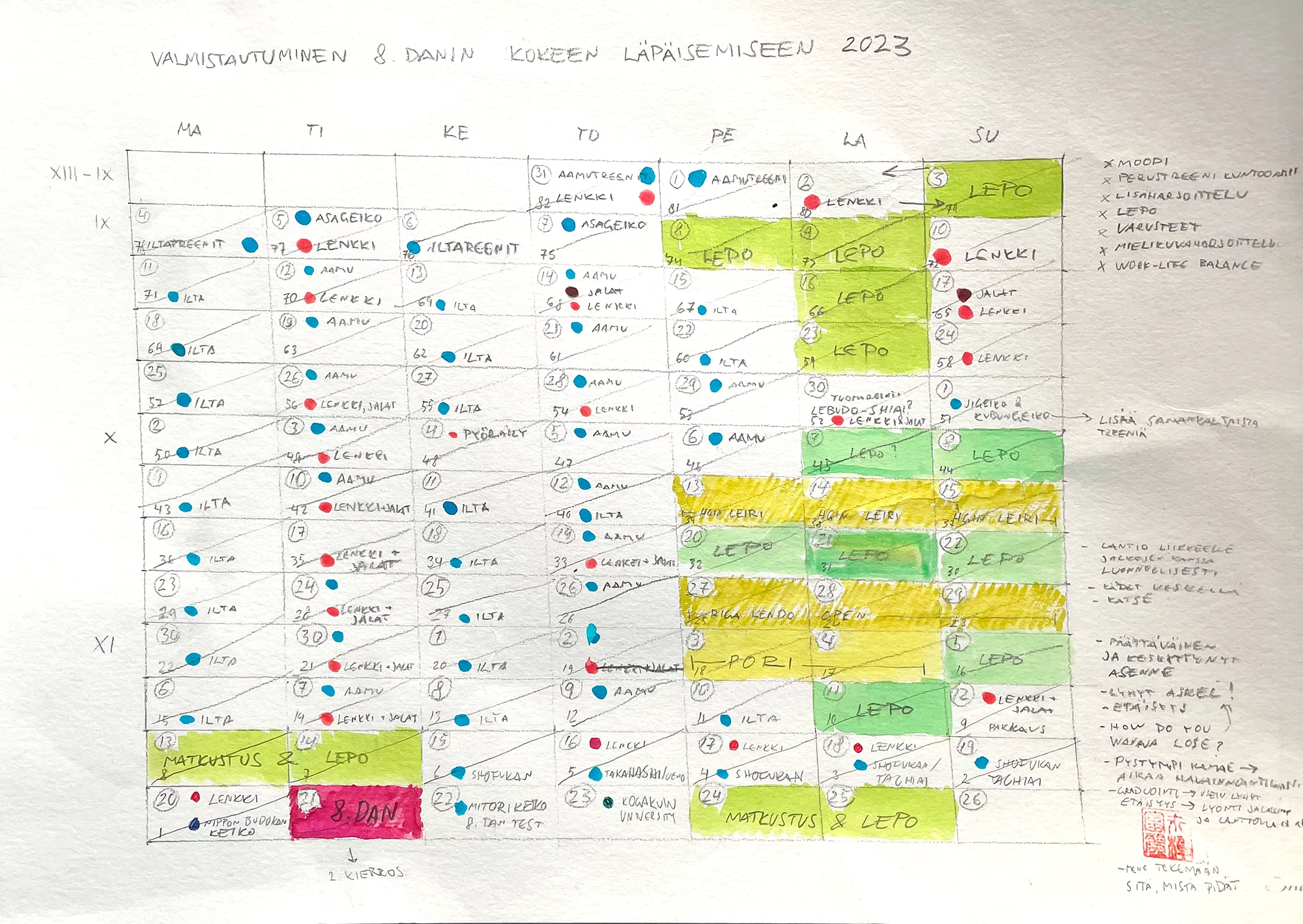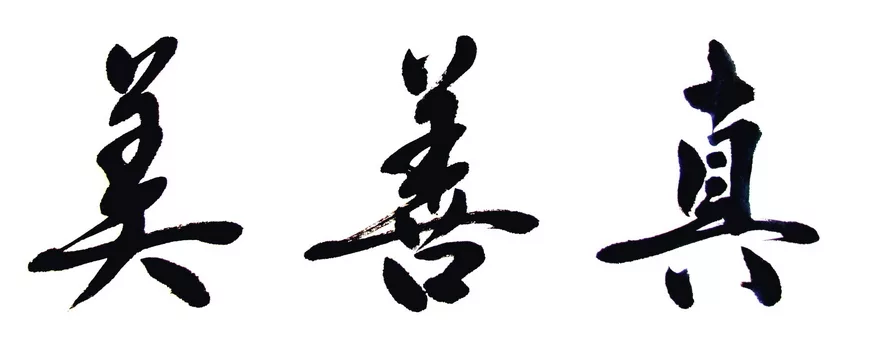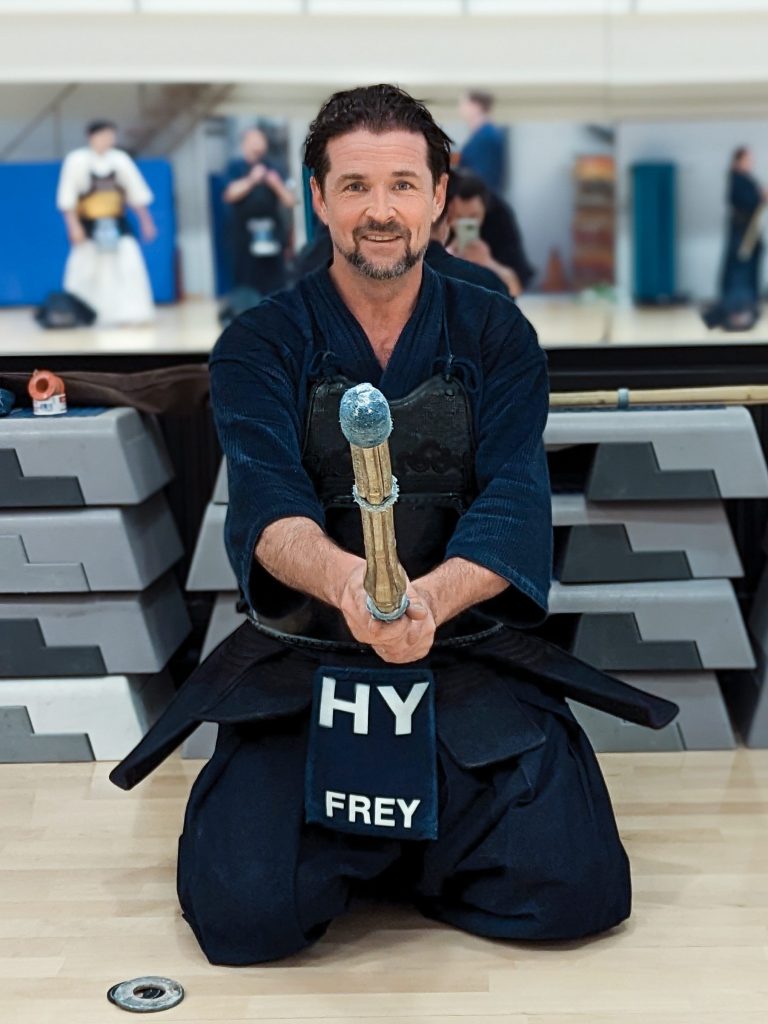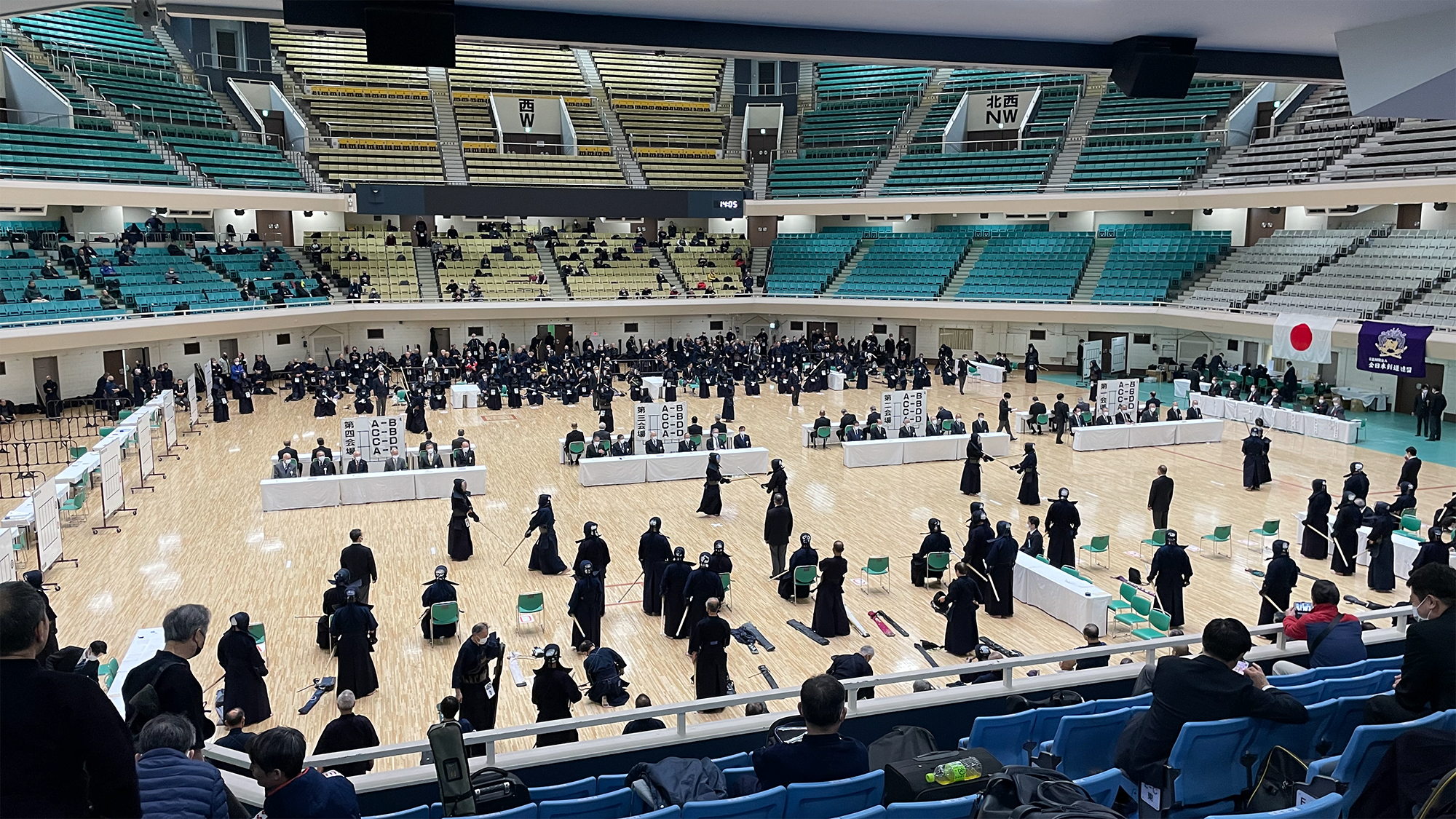The day of the shinsa in Nippon Budokan.
Photo credits: Markus Frey.
You are probably here because you read the first part of the interview with Markus Frey (7th dan, kyoshi) and you are keen to know what did he say after the cliffhanger-part of the previous article. We can assure you, your patience is rewarded (with this article, of course). Enjoy!
_______________
Merci Czimbalmos: So, on your second attempt of the hachidan shinsa in November 2023 you got into the second round. Could you please tell about that experience?
__________
Markus Frey: Well, I started to prepare very systematically in the beginning of June. I had it in my mind for the whole spring of 2023, but from June I made a day by day plan. I decided what I will do on each day and in my calendar there was a box for each day. Luckily, I was able to have a good preparation with no interruptions: I was healthy and I could develop my condition. I paid attention to rest and nutrition, all these kinds of things, and I really took good care of myself. I didn’t even drink beer. All this built up the self-confidence during the process itself. I felt that I’m well prepared. However, when I went to Tokyo a week before the examination, I was really nervous. I had this anxiety, and I only wanted the shinsa to be over. I also had doubts about whether it’s possible to pass at least the first round. In Tokyo, I went for a run every morning around 6:00 just to deal with the jet lag and to wake up my body. The shinsa starts at 9:30 in the morning, so I wanted to be prepared for an early start. On the morning of the shinsa, I also went for a run, and while I was running, my disbelief about the possibilities changed. A question, “what if it’s possible?” appeared in me suddenly. It was a really strong feeling. I don’t know where it came from – but after I got this thought, I became super calm. It completely changed my mind, and somehow this peace and ease came over me and it lasted the whole day. I really don’t know how, but it was like a “magical thing” to happen, something that you wish for. It just came to me and I had this grounded feeling in my legs and in my stomach and in my core: a very good feeling in my body. Then everything “just happened.” After my first fight in the shinsa, I had a feeling that this is not going well, and I felt that I am losing this, but at the same time I remained very calm, and I just said to myself, “Okay, there’s one more match. Let’s see how it goes.” Luckily the second match went very well. It was also the match against the guy who was really dominating the whole group of four people, and I felt like I did well against him. Maybe that was reason why I went to the second round. I’ve been analyzing the matches after: the first one was not that bad as I felt then, but I still have this feeling that the second one was the decisive match. It was really about the mindset, and what happened to me in the morning. I could really get the best out of myself.

Markus’ calendar during this preparation for the hachidan shinsa.
Photo credit: Markus Frey.
__________
MC: I’m not sure if this is an “esoteric question” or not, but my own memory of my last shinsa is, that I basically don’t remember anything besides the first and the last strikes of the two tachiais. I tend to associate this with “flow,”1 or I guess some would perhaps say that it’s connected to “fudoshin”2….
__________
MF: Yes, definitely! I had the same kind of feeling, almost like being in a different “universe.” I remember only small glimpses of things, but really can’t remember what was going on. This can happen when there is a strong focus on an activity and you get into a “flow” or a “zone.” The same thing happened to me also during the second round: I felt I was “somewhere,” and things were just happening, without me pushing them.
__________
MC: How did it feel like when you got to see that you got into the second round?
__________
MF: Well, I was hoping for it and obviously I was very, very happy because it’s a big thing! Maybe not all the Europeans understand this, but even for the Japanese professionals, it is a big thing. Those Japanese guys who went to the second round, they got a lot of congratulations from their friends. So, obviously I was really happy! At the same time, I knew that I had to be careful. I was worrying that I would lose the concentration and be satisfied already and then do badly in the second round, so I tried to keep my cool a little bit. I just went out to have ramen and just to relax and keep my concentration.
__________
MC: If I remember correctly, somewhere around 10 per cent passes the first round. How did the rest of the day, and the second round feel?
__________
MF: Yeah, it is more or less 10 percent. We were 926 trying the first round, and 92 of us passed to the second round, and then out of those 92, only four people passed. During the first round, there is somewhat of a pressure that “you need to succeed.” Obviously, the aim is to pass the exam, so of course you really want to succeed already in the first round. The difference between the two rounds is, that in the second round you already know that only so few will pass, that you just don’t care anymore. You just try to go there, and you do your best. I almost felt even more relaxed before the second round than before the first one. You just go, do your best, and then there will be the outcome.
__________
MC: Are you satisfied with the outcome?
__________
MF: Yes! But: I’ve also watched the videos from my shinsa. You know, when time passes you start to have these thoughts and feelings that make you question yourself. For example “what if I would have landed that strike?” I hit a kaeshi-do in both matches in the second round, but my opponent was very quick and my strikes were not good enough. So, of course, I then started to have second thoughts: “what if I would have landed those kaeshi-dos very well?” or “would it have been the turning point?” These kinds of speculations, you know? But of course, even now, after a couple of months I am still very happy with the results.
__________
MC: I think that sometimes, especially in Europe, when the performance in shinsa “versus” shiai is discussed, people tend to refer to these two as two completely different genre – at least in my own experience. My personal opinion is of course, that while they are really different genre in many ways, there are rather big overlaps in terms of when is a performance successful in one and in the other. Since you have not actively competed since 2008, and you have been a frequent shinpan at EKCs, WKCs, and other competitions, obviously now you’re in a somewhat different stage of your “kendo career.” From this perspective of a kendoka, what do you think, about shinsa “versus” shiai?
__________
MF: My take on kendo is, that there is not much of a difference between these two. In my generation for example Mikko Salonen3 and me and other people who were competing in the Finnish team during the 1990’s and early 2000, we went to the finals in the EKC, and we got to the third place. We had this idea, that we would like to do “standard and good” kendo also in shiai. Maybe this is why we never got to the highest step of the podium, but I can say, that for me shinsa and shiai are the same thing. Of course, there are some aspects that are different. For example, blocking in shinsa is very different from blocking in shiai, but still, both are about making an ippon. You cannot pass a rokudan, nanadan, hachidan shinsa without scoring an ippon, in my opinion. So, in that way, it’s the same thing, but it’s maybe the quality that really counts. I’m not sure if this is really answering your question, but I find them quite similar. I like the idea what some senseis say: “You must do jigeiko like if it was shiai, and shiai like if it was jigeiko.” This means that you must have the focus and the concentration of shiai in jigeiko, but you have to have the straight, good kihon in your shiai. The same applies for gradings.
__________
MC: Right. Yes, this was what I was after, you did answer the question. Surely, there are certain differences, such as “decreasing certain risks” of being hit, but I was more referring to your take on the approach and the feeling. Maybe the genre is different, but the attitude is somewhat similar.
__________
MF: I agree.
__________
MC: Earlier you mentioned the help you got from Iwatate sensei and other hachidans. What about the Finnish scene? What was the most helpful for you, in your home base?
__________
MF: Well, the biggest help is the daily practice with the people both at the University of Helsinki and at Ki-Ken-Tai-Icchi. I am really grateful that I have a chance to practice with you people five times a week if I want. You are my teachers as well. It’s really like we have very good circumstances in Helsinki. We, of course, lack the chance to practice with hachidan senseis, but if you really want to push yourself forward, we have the possibility to practice almost every day. Even in Japan, maybe if we exclude the tokuren, if we think for example about high school or university kendo teachers: they are spending their days teaching and practicing with the young people, it’s not that much different from what I’m doing back home. Even maybe for the police, when you are preparing for the hachidan you’re already in a position when your competition career is over and you’re loaded with all kinds of responsibilities outside of the dojo. When your rank in the police force is higher you have responsibility and all kinds of administrative things, so I am sure that not all policemen are able to practice as much as I can on a weekly basis!In order to develop yourself, it is really taking responsibility of your own development and then just trying to make the best out of it. I really think it is just like that.
__________
MC: That is a fair point, I think!
__________
MF: Of course, you need to be alert and watch yourself. It’s very easy to be satisfied. But if you’re too satisfied, then the development stops. You need to remain critical. Enjoy the practice, but also be critical and try to improve yourself all the time.
__________
MC: I don’t think that there is any magic potion or whatever, but what would you advise to people who are aiming for non-kodansha grades, and for those who are aiming for kodansha grades?
__________
MF: For both groups, regular practice is the most important. For passing lower grades, you need to practice. If you involve yourself in the process of getting better, eventually you will have the result, but you really need to practice. For the higher grades, it is more about your attitude, and the psychological things. You need to make a plan. You know the saying “If you fail to plan, you plan to fail.” It’s more about the mindset when the margins are getting smaller and your opponents are on the same high level as you are. At that point, it is more about the preparation and understanding that there are things that you can control, but then there are things that you can’t control. You can control your attitude, your preparation, how you take care of yourself, what you do, for example a month before, a week before the grading, or on the day of the grading. But then, you also need to understand that you can’t control the time of the shinsa, your opponent, your fighting order, the circumstances. It is what it is. So, understanding this and then concentrating on the things that you can control, this is very important. Once you have set your mind you decide for example: “I will go the grading in November, and I will do this and this and this in a given time.” If you do this and you have a good plan, you follow it and just trust the process. You do everything that you plan to do. Then, in the case you don’t pass the shinsa, you have no regrets. You know that you did the best you could in the given time, with the given resources. You should cherish this process. Then your life continues and you can practice more or differently. You can maybe take it easy for a couple of weeks and then make plans for the future. I think this is necessary. I have failed now two times, but this failing and the grade I’m trying to get won’t become a huge obstacle that is standing my way. It is a pity when people keep pushing and they don’t pass, and then eventually they stop. I think making a good plan and valuing the process will also prepare you for the losses. This is important.
__________
MC: I think this is a very important point that many tend to overlook. With all the development that takes place when we really prepare, whether we pass an exam or not. I am wondering, is there anything else you would like to add or still mention?
__________
MF: Well, maybe, I already said it, but I find the “hachidan challenge” very interesting. It also feels like it’s a huge wall that you try to try to climb, and it’s a slippery wall. It doesn’t have the handles helping you go up easily. In my case, I feel like this challenge has had a huge impact on my kendo, and I think my kendo has gotten better while I have been preparing. I have been using the hachidan shinsa as a guide. I think this is not just for me, I think it’s necessary for everybody who are on a higher level. They should decide what kind of kendo they want to do. I was using this shinsa for that. I’ve been spending a lot of thoughts on thinking about the posture: not only the psychical posture, but the values, and the deeper things. I like and relate to the calligraphy on the wall of my kendo club, Ki-Ken-Tai-Icchi. There is written Shin, Zen, Bi – Truth, Goodness and Beauty. I think those are values I would like my kendo to have. To put it in short, I think you can use gradings to improve your kendo a lot.

Shin-zen-bi (Japanese: 真善美).
Photo credit: Markus Frey.
Some of the readers may not know, but Finland – as well as most of the Nordic countries – is very casual and informal in most instances. This also means that we are not only fortunate to train with Markus Frey sensei, but we are also fortunate to have a free exchange of thoughts with him about kendo, and about things that would perhaps be unimaginable in the kendo circles of many countries and the kendo circles. We by no means take this for granted, and would therefore like to thank Markus for his openness to talk about this experience to all of us at the afterkeiko breakfast.

- The term “flow” in psychology was coined by Mihály Csíkszentmihályi. Flow is a state of mind that occurs when a person is totally immersed in an activity. Flow can occur during a wide variety of activities or tasks, including sports, or when a person is immersed in their hobbies, or engaged in learning. ↩︎
- Fudoshin, (Japanese: 不動心, literally: “immovable mind,” unmoving heart”). Fudoshin is a philosophical or mental dimension to Japanese martial arts. It is often described as the ability to remain calm and imperturbable under pressure. ↩︎
- Mikko Salonen (7th dan, kyoshi). We won’t say much more in this footnote, because there will be an interview with him too. Stay tuned! ↩︎


Leave a Reply